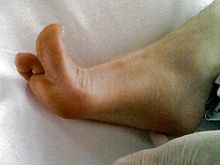Babinski reflex
The Babinski reflex or Babinski sign is a pathological reflex that occurs when the pyramidal path is damaged ( pyramidal path sign ). The reflex is named after the Polish-French neurologist Joseph Babinski (1857–1932) who discovered the neurological background of this disorder in 1896. In infants it is physiological .
Tripping
The normal plantar reflex ( plantar reflex ) is a foreign reflex and responds when the sole is rubbed with a gripping movement ( plantar flexion ) of the toes. If the pyramidal tract is damaged, brushing the outer edge of the foot in particular leads to an upward movement of the big toe ( dorsiflexion ), while the other toes perform plantar flexion.
The biological meaning of the Babinski reflex is just as unknown as its interconnection ( reflex arc ). The usefulness of its examination as part of the neurological examination is also under discussion. According to one theory, the Babinski reflex represents a flexion synergism of the foot flexor muscles. In the course of development, however, a toe flexor muscle has developed into a big toe extensor. If the overriding control of the foot muscles fails in the case of spinal cord or brain lesions, the muscle groups that belong together in earlier stages of development are activated again together. This leads to the extension of the big toe and flexion of the little toe.
The presence of the reflex in newborns and infants is attributed to the fact that the nerve connections of the central nervous system are not yet fully developed. After a few months, inhibitory nerve tracts ( inhibitory efferents ) from the central nervous system, which modulate the simple spinal cord reflexes, are formed and the Babinski reflex is suppressed.
literature
- Wilhelm Specht : Contribution to the clinical significance and pathogenesis of the Babinski's reflex . Monthly journal for psychiatry and neurology 13 (1903), pp. 81-96.
Individual evidence
- ↑ TM Miller, SC Johnston: Should the Babinski sign be part of the routine neurologic examination? Neurology 65 (2005), pp. 1165-1168. PMID 16247040
